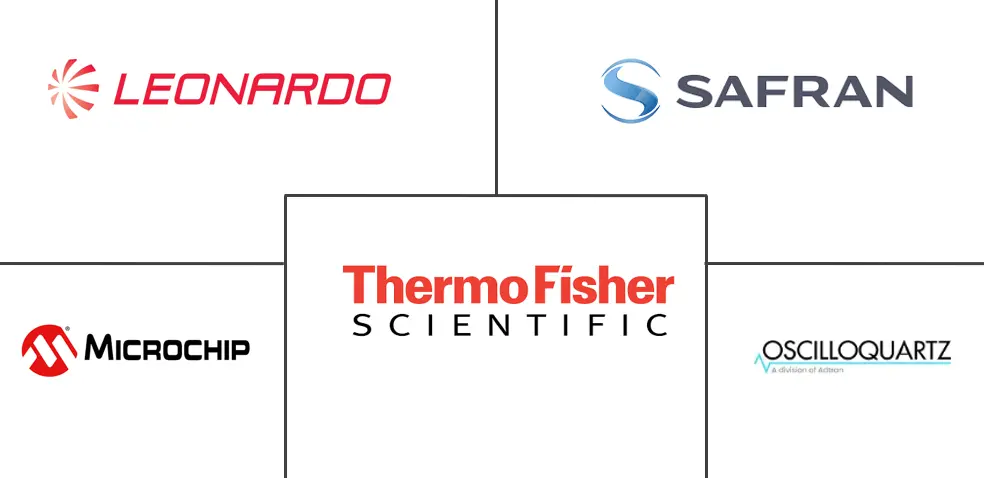Atomic Clock Market Size and Share
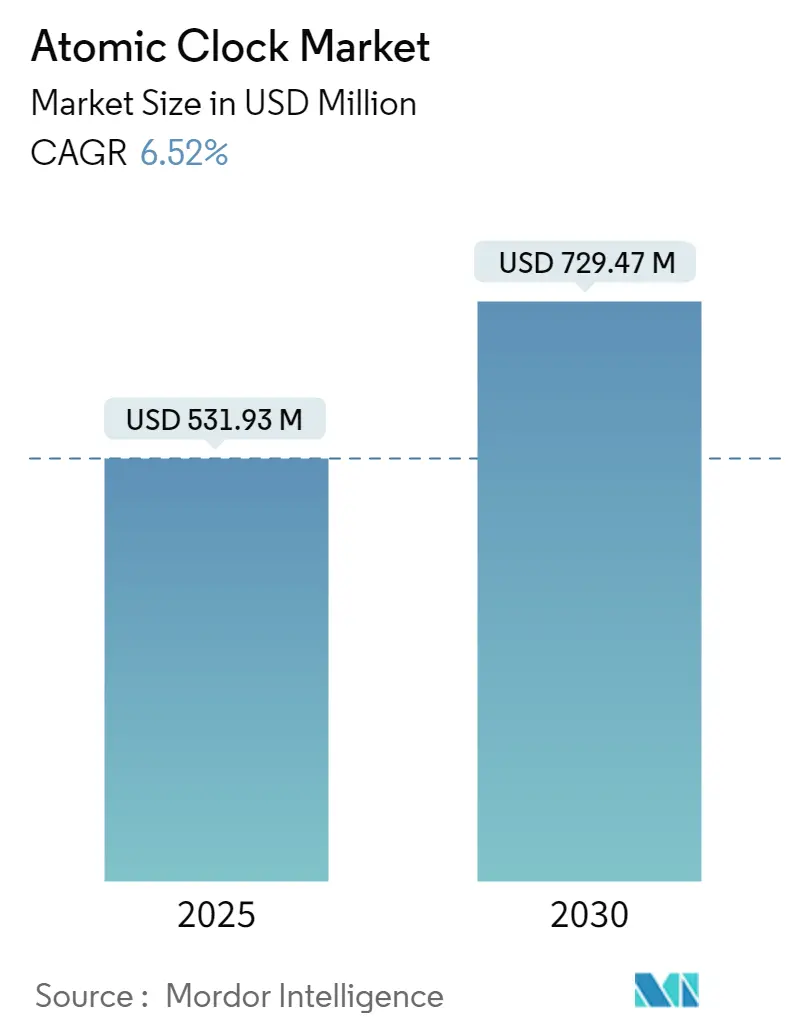
Atomic Clock Market Analysis by Mordor Intelligence
The Atomic Clock Market size is estimated at USD 531.93 million in 2025, and is expected to reach USD 729.47 million by 2030, at a CAGR of 6.52% during the forecast period (2025-2030).
The atomic clock industry is experiencing significant transformation driven by increasing defense modernization initiatives worldwide. Major powers are substantially expanding their military capabilities, with Japan's defense budget reaching USD 52.67 billion in 2023, marking a 26% increase from the previous year. This surge in defense spending has catalyzed investments in advanced navigation systems, precision-guided munitions, and military communication networks that rely heavily on atomic clock technology. The integration of atomic clocks into military platforms has become crucial for maintaining strategic advantages in modern warfare scenarios.
Space exploration and satellite navigation systems are emerging as pivotal growth drivers for the atomic clock market. Countries are intensifying their space programs, with China investing approximately USD 12 billion in space-related activities in 2022, while India allocated USD 1.5 billion for space initiatives in FY 2023-2024. This heightened focus on space exploration is exemplified by significant developments such as India's successful launch of its first second-generation navigation satellite incorporating an indigenous atomic clock in May 2023, marking a crucial step toward technological independence in space navigation.
The industry is witnessing a paradigm shift toward quantum-enhanced atomic clocks and space-based timing systems. In February 2023, the European Space Agency proposed establishing a new time zone on the moon, highlighting the growing importance of precise timekeeping in space exploration. This initiative aims to facilitate communication between various spacecraft and support the planned implementation of a global satellite navigation system around 2030. The advancement in quantum technologies has led to the development of commercial optical atomic clocks by companies like Vector Atomic, capable of maintaining precision to 10 femtoseconds after a day.
The market is characterized by increasing emphasis on indigenous development capabilities and international collaborations. In December 2023, China successfully launched two new BeiDou satellites equipped with miniaturized hydrogen atomic clocks, demonstrating the growing trend toward self-reliance in critical timing technologies. These developments are complemented by rising investments in research and development of next-generation atomic clocks, focusing on enhanced precision, reduced size, and improved reliability for various applications in defense and space sectors. The industry's evolution is further shaped by the integration of cybersecurity features and the development of resilient timing solutions for critical infrastructure protection.
Global Atomic Clock Market Trends and Insights
Rapid Technological Advancements
The atomic clock market is experiencing significant momentum driven by continuous technological innovations in material science, manufacturing processes, and clock design. The miniaturization of cesium clocks represents a major advancement, enabling their widespread adoption in defense applications. These smaller-than-ever portable atomic clocks are being equipped in unmanned vehicles and portable systems, with their compact designs increasing adoption in various mission-critical scenarios. For instance, in July 2022, ADVA launched its "coreSync OSA 3300-HP" high-performance optical cesium clock, setting a new benchmark for precision and availability with a 10-year lifetime compared to the five years offered by currently available high-performance magnetic clocks.
The evolution of atomic clock technology is particularly evident in naval applications, where improved synchronization contributes to enhanced navigation and communication capabilities. In March 2022, the UK Royal Navy demonstrated this advancement by installing an atomic clock on the HMS Prince of Wales aircraft carrier, providing highly accurate time measurement that allows the carrier's combat systems to synchronize even when GPS is unavailable. Similarly, in the space industry, technological progress is enabling more sophisticated satellite systems. For instance, in June 2022, the French defense procurement agency awarded THALES and Syrlinks a contract to jointly develop CHRONOS, a cutting-edge quantum clock for the country's armed forces, specifically designed to enable defense-related electronic equipment to operate in GPS-denied environments.
Growing Demand for Precision Timing in Emerging Technologies
The increasing demand for precision timing in emerging technologies is reshaping the atomic clock market landscape, particularly in defense applications where highly accurate timekeeping becomes crucial for mission success. The integration of rubidium clocks in modern military systems is exemplified by recent developments such as the US Defense Advanced Research Projects Agency (DARPA) awarding a USD 6.2 million contract to Northrop Grumman in February 2023 for the H6 program. This initiative aims to develop ultra-small, low-power rubidium clocks that can maintain microsecond precision for at least a week in temperatures ranging from -40 to 85 degrees Celsius, demonstrating the critical need for precise timing in advanced military operations.
The demand for precision timing is further illustrated by significant developments in space applications. In May 2023, India achieved a milestone by launching its first second-generation navigation satellite using an indigenous atomic clock, marking a significant advancement in autonomous navigation capabilities. Additionally, in June 2023, Galileo Second Generation (G2) entered its Orbit Validation development phase, with enhanced atomic clocks being a key feature of the new satellites. Each G2 satellite will be equipped with six advanced atomic clocks, enabling improved communication and cross-checking capabilities. These developments underscore the growing importance of precise timing in emerging space technologies and defense applications, driving continuous innovation in atomic clock technology.
Segment Analysis: By Type
Cesium (Cs) Segment in Atomic Clock Market
The cesium clock segment maintains its dominant position in the atomic clock market, commanding approximately 42% of the market share in 2024. This leadership position is attributed to the superior performance and reliability of cesium atomic clocks, which offer unparalleled accuracy and stability in timekeeping. The segment's prominence is particularly evident in critical applications such as global navigation satellite systems (GNSS), telecommunications networks, and scientific research. Cesium atomic clocks are extensively deployed in military and defense applications, where precise timing is crucial for mission success. The technology's ability to maintain accuracy within one second over millions of years makes it indispensable for applications requiring extreme precision, such as satellite navigation and defense systems.
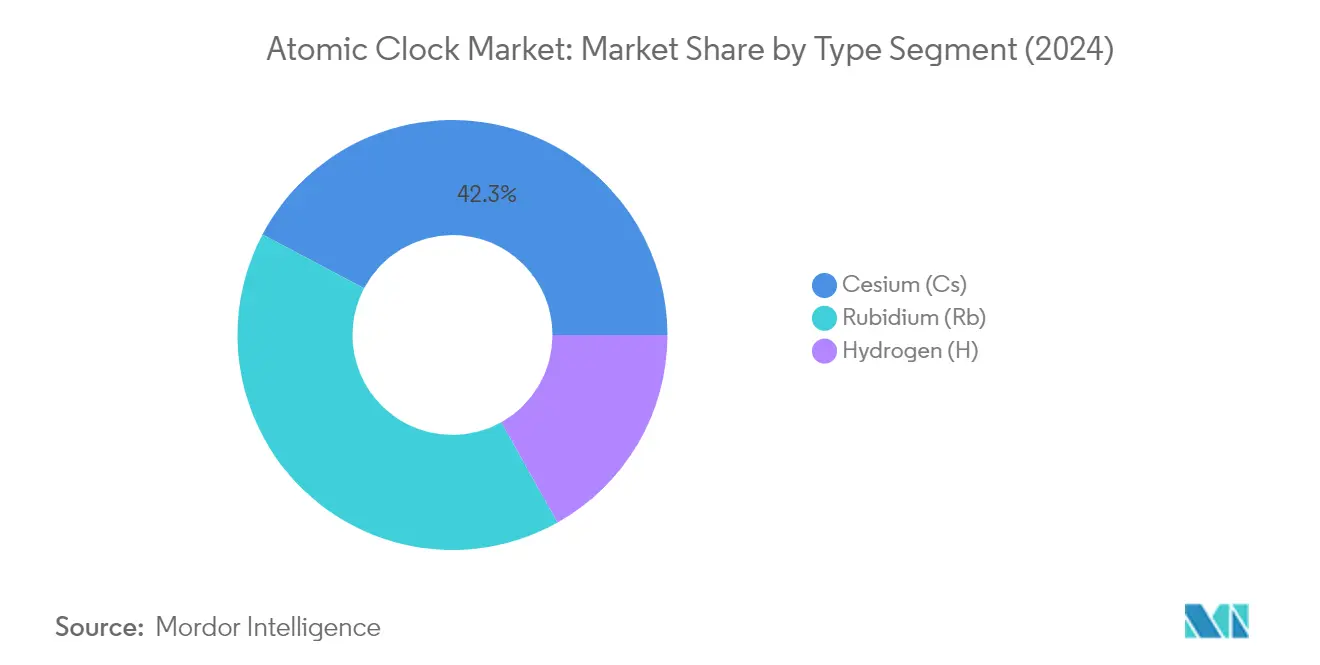
Rubidium (Rb) Segment in Atomic Clock Market
The rubidium clock segment is emerging as the fastest-growing segment in the atomic clock market, projected to expand at approximately 7.5% CAGR from 2024 to 2029. This growth is driven by technological advancements in miniaturization and improved performance characteristics of rubidium-based timing solutions. The segment's expansion is further supported by increasing adoption in space applications, particularly in satellite communications and navigation systems. Recent developments in chip-scale rubidium atomic clocks have opened new possibilities for integration into smaller platforms and portable devices, making them increasingly attractive for various military and aerospace applications. The segment's growth is also bolstered by the rising demand for cost-effective yet highly accurate timing solutions in emerging technologies such as 5G networks and autonomous systems.
Remaining Segments in Atomic Clock Market by Type
The Hydrogen Maser atomic clock segment, while representing a smaller portion of the market, continues to play a crucial role in specialized applications requiring ultra-high precision. These atomic clocks are particularly valued in deep space exploration, advanced research facilities, and high-precision scientific applications. Hydrogen Maser atomic clocks offer exceptional stability and precision, making them ideal for applications where absolute accuracy is paramount. Despite their higher complexity and maintenance requirements, these systems remain essential in national laboratories, space agencies, and other institutions requiring the highest levels of timing precision.
Segment Analysis: By End User
Defense Segment in Atomic Clock Market
The defense segment maintains its dominant position in the atomic clock market, commanding approximately 74% market share in 2024. This substantial market presence is driven by the critical role of atomic clocks in various military applications, from combat aircraft and helicopters to naval vessels and unmanned systems. The segment's strength is particularly evident in applications such as precision navigation, secure communications, and electronic warfare systems. Defense organizations worldwide are increasingly integrating atomic clocks into their modernization programs, especially in GPS-denied environments where precise timing is crucial for mission success. The segment's robustness is further reinforced by the growing adoption of atomic clocks in portable military systems, armored vehicles, and submarine applications, where timing accuracy directly impacts operational effectiveness and mission-critical capabilities.
Space Segment in Atomic Clock Market
The space segment is emerging as the fastest-growing sector in the atomic clock market, with a projected growth rate of approximately 7% during 2024-2029. This accelerated growth is primarily driven by the increasing deployment of satellites for navigation, communication, and earth observation missions. The segment's expansion is further fueled by the rising number of space exploration initiatives and the growing emphasis on developing autonomous space navigation capabilities. Space agencies and commercial space companies are increasingly investing in advanced atomic clock technologies to enhance the precision of their orbital operations and deep space missions. The development of more compact and efficient atomic clocks specifically designed for space applications, coupled with the increasing number of satellite constellation deployments, is expected to maintain this segment's strong growth trajectory through the forecast period.
Segment Analysis: By Application
Navigation Segment in Atomic Clock Market
The Navigation segment has emerged as both the largest and fastest-growing segment in the atomic clock market, commanding approximately 34% of the market share in 2024. This dominance is primarily driven by the increasing integration of atomic clocks in global navigation satellite systems (GNSS), precision positioning systems, and military navigation applications. The segment's growth is propelled by the rising demand for highly accurate timing signals in satellite-based navigation systems, which are crucial for military operations, autonomous navigation in space missions, and precise positioning capabilities. The segment is projected to maintain its leadership position with an expected growth rate of nearly 7% from 2024 to 2029, driven by technological advancements in navigation systems, increasing deployment of navigation satellites, and growing adoption of atomic clocks in emerging space exploration missions. The development of next-generation navigation systems and the increasing focus on enhancing positioning accuracy in defense applications continue to fuel the segment's expansion.
Remaining Segments in Application Market
The atomic clock market encompasses several other significant application segments including Electronic Warfare, Surveillance, Telemetry, and Communication. The Electronic Warfare segment plays a crucial role in military operations, utilizing atomic clocks for precise timing in electronic countermeasures and defense systems. The Surveillance segment leverages atomic clock technology for accurate synchronization in monitoring and reconnaissance applications, while the Telemetry segment relies on atomic clocks for precise data transmission and measurement in aerospace and defense operations. The Communication segment utilizes atomic clocks for maintaining synchronization in military communication networks, secure data transmission, and satellite communication systems. These segments collectively contribute to the market's growth, driven by increasing defense modernization programs, growing emphasis on military communications, and rising investments in space exploration activities.
Atomic Clock Market Geography Segment Analysis
Atomic Clock Market in North America
North America represents a dominant force in the atomic clock market, driven by substantial technological advancements and significant investments in research and development. The region's market is characterized by strong partnerships between government agencies, research institutions, and private companies that foster innovation and drive widespread adoption of atomic clock technologies. The United States and Canada are the key contributors to market growth, with both countries demonstrating robust development in precision timing applications across various sectors, including defense, space exploration, and satellite navigation systems.
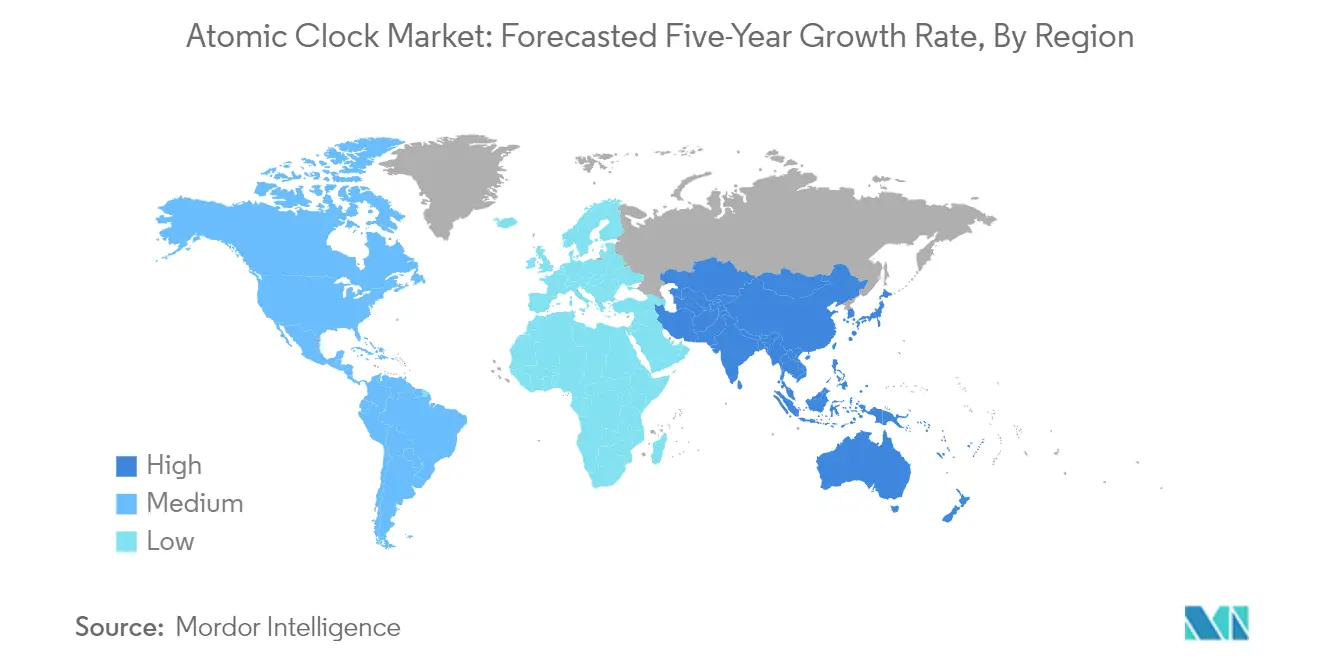
Atomic Clock Market in United States
The United States leads the North American atomic clock market with approximately 81% market share in 2024, establishing itself as the region's largest market for atomic clock technologies. The country's dominance is supported by significant defense spending and continuous modernization of military equipment. The U.S. military's increasing focus on precision timing for various applications, including combat aircraft, unmanned vehicles, and naval operations, drives market growth. The country also maintains a strong presence in space exploration and satellite navigation systems, where atomic clocks play a crucial role in ensuring accurate timing and synchronization.
Atomic Clock Market in Canada
Canada demonstrates strong market potential with a projected growth rate of approximately 7% during 2024-2029. The country's market is driven by increasing investments in defense modernization programs and growing adoption of atomic clocks in various military applications. Canadian defense forces are increasingly incorporating atomic clock technology in their navigation and communication systems, particularly in unmanned vehicles and advanced military platforms. The country's focus on enhancing its space capabilities and satellite navigation systems further contributes to market growth.
Atomic Clock Market in Latin America
Latin America's atomic clock market is experiencing steady growth, driven by increasing investments in defense and space exploration initiatives. The region's market is primarily influenced by Brazil's significant defense modernization programs and growing focus on indigenous satellite navigation capabilities. Other Latin American countries are also showing increased interest in atomic clock technologies, particularly for military applications and telecommunications infrastructure development.
Atomic Clock Market in Brazil
Brazil dominates the Latin American market with approximately 53% market share in 2024, establishing itself as the regional leader in atomic clock technology adoption. The country has developed significant capabilities in cesium clock technology, including three types of cesium atomic clocks. Brazil's strong presence in both civil and military aviation sectors, coupled with its ambitious space program and satellite communication initiatives, drives the demand for precise timing solutions.
Atomic Clock Market Growth in Brazil
Brazil continues to demonstrate strong growth potential with an expected growth rate of approximately 7% during 2024-2029. The country's market expansion is driven by increasing investments in defense modernization, including the procurement of advanced aircraft and missile systems that require precise timing capabilities. Brazil's focus on developing indigenous satellite positioning systems and enhancing its space capabilities further supports market growth.
Atomic Clock Market in Asia-Pacific
The Asia-Pacific region represents a dynamic market for atomic clock technologies, characterized by rapid industrialization and expanding satellite-based services. Countries like China, Japan, and India are making significant strides in developing and implementing atomic clock technologies for various applications. The region's market is driven by increasing defense expenditure, space exploration initiatives, and the development of indigenous satellite navigation systems.
Atomic Clock Market in China
China leads the Asia-Pacific market as the largest consumer of atomic clock technologies. The country's dominance is supported by its robust space program, particularly the BeiDou navigation satellite system, which extensively uses atomic clocks. China's significant investments in defense modernization and indigenous technological capabilities have strengthened its position in the atomic clock market.
Atomic Clock Market in Japan
Japan emerges as the fastest-growing market in the Asia-Pacific region. The country's market growth is driven by increasing defense spending and significant investments in space technology. Japan's focus on developing advanced timing solutions for military applications and satellite systems, coupled with its strong technological infrastructure, positions it as a key player in the regional market.
Atomic Clock Market in Europe
Europe maintains a strong position in the atomic clock market, supported by advanced research capabilities and significant investments in space programs. The region's market is characterized by strong collaboration among countries through initiatives like the European Space Agency and the Galileo satellite navigation system. The United Kingdom leads the European market, benefiting from its strong defense industry and space sector investments, while Russia demonstrates the fastest growth rate, driven by its extensive space program and GLONASS navigation system development.
Atomic Clock Market in Middle East & Africa
The Middle East & Africa region shows growing adoption of atomic clock technologies, primarily driven by increasing investments in defense modernization and space capabilities. Saudi Arabia leads the regional market, supported by significant defense spending and growing focus on space sector development, while the United Arab Emirates shows the fastest growth, driven by its ambitious space program and increasing defense modernization initiatives. The region's market is characterized by growing investments in satellite communication systems and defense applications.
Competitive Landscape
Top Companies in Atomic Clock Market
The atomic clock market features established players like Safran, Microchip Technology, Leonardo SpA, and Thermo Fisher Scientific, leading innovation and market development. Companies are increasingly focusing on miniaturization technologies and quantum sensing-enhanced timing solutions to meet evolving aerospace and defense requirements. Strategic partnerships and collaborations with research institutions are driving technological advancement, particularly in developing more precise and reliable atomic clock systems. The industry demonstrates a strong emphasis on research and development, with companies investing heavily in improving clock accuracy, reducing size, and enhancing integration capabilities. Operational agility is evident through the development of customized solutions for specific applications, while geographic expansion strategies target emerging markets in the Asia-Pacific and Middle East regions. Market leaders are also prioritizing the development of cybersecurity features and resilient positioning, navigation, and timing systems to address growing security concerns.
Consolidated Market with High Entry Barriers
The atomic clock market exhibits a highly consolidated structure dominated by large multinational corporations with extensive aerospace and defense portfolios. These established players leverage their strong research capabilities, manufacturing expertise, and long-standing relationships with government and military customers to maintain their market positions. The market's high technological barriers to entry, coupled with stringent regulatory requirements and certification processes, make it challenging for new entrants to establish themselves. The industry is characterized by the presence of both specialized atomic clock manufacturers and diversified technology conglomerates that integrate atomic clock production into their broader product offerings.
The market has witnessed strategic acquisitions aimed at expanding technological capabilities and market reach, exemplified by Safran's acquisition of Orolia to strengthen its position in resilient positioning, navigation, and timing systems. Companies are increasingly forming strategic alliances with research institutions and technology partners to enhance their innovation capabilities and address emerging market needs. Regional players focus on serving specific geographic markets or specialized applications, while global leaders maintain their dominance through comprehensive product portfolios and extensive distribution networks.
Innovation and Integration Drive Future Success
Success in the atomic clock market increasingly depends on companies' ability to innovate while maintaining cost-effectiveness and reliability. Incumbent players must focus on developing next-generation atomic clock technologies, particularly in areas such as quantum enhancement and miniaturization, while maintaining strong relationships with key defense and aerospace customers. The ability to integrate atomic clock solutions with emerging technologies like quantum communication systems and advanced navigation platforms will be crucial for maintaining market leadership. Companies must also invest in developing comprehensive service and support networks to address the complex maintenance and calibration requirements of atomic clock systems.
For contenders seeking to gain market share, specialization in specific applications or regional markets presents a viable strategy for growth. Success factors include developing cost-effective solutions for commercial applications while meeting stringent military and aerospace standards. The increasing focus on space-based applications and commercial space ventures offers opportunities for new market entrants to establish themselves in emerging niches. Companies must also consider potential regulatory changes, particularly in areas such as frequency standard allocation and timing standards, while developing strategies to address the high concentration of end-users in the defense and aerospace sectors.
Atomic Clock Industry Leaders
-
Microchip Technology Inc.
-
Safran
-
Thermo Fisher Scientific Inc.
-
Oscilloquartz (Adtran Networks SE)
-
Leonardo SpA
- *Disclaimer: Major Players sorted in no particular order
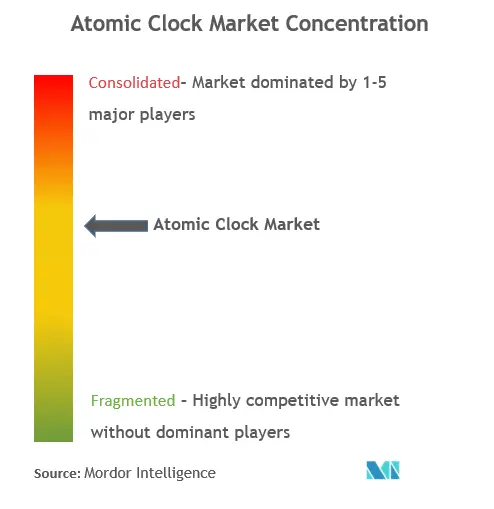
Recent Industry Developments
In June 2023, Microchip Technology Inc. launched the 5071B cesium atomic clock that can carry out autonomous timekeeping for months in the instance of GNSS denials.
In June 2022, Orolia SA, a subsidiary of Safran, introduced an upgraded edition of its small size, weight, power, and cost (SWaP-C) miniaturized rubidium oscillator product line, the MRO-50, to meet the latest military and aerospace requirements.
Global Atomic Clock Market Report Scope
An atomic clock uses a resonator with resonance frequencies of atoms. A resonator is regulated by the frequency of microwave electromagnetic radiation emitted by the quantum transition of an atom. Resonation at extremely consistent frequencies is possible, an added advantage to this approach. In terms of accuracy and precision, atomic clocks are the most accurate.
The market is segmented by application, type, end user, and geography. According to type, the market is divided into cesium (Cs) atomic clock, rubidium (Rb) atomic clock, and hydrogen (H) maser atomic clock. The market is segmented into surveillance, navigation, electronic warfare, telemetry, and communication-based on application. By end user, the market is segmented into defense and space. The report includes the market size and forecasts in significant countries across different regions. The forecasts and market sizes have been provided in value (USD).
| Rubidium (Rb) Atomic Clock |
| Cesium (Cs) Atomic Clock |
| Hydrogen (H) Maser Atomic Clock |
| Defense | Combat Aircraft and Helicopters? |
| Unmanned Vehicles? | |
| Armoured Vehicles | |
| Portable Systems | |
| Naval Ships (Destroyers, Frigates, etc) | |
| Submarines? | |
| Patrol Vessels? | |
| Space |
| Surveillance |
| Navigation |
| Electronic Warfare? |
| Telemetry |
| Communication |
| North America | United States |
| Canada | |
| Europe | United Kingdom |
| Germany | |
| France | |
| Russia | |
| Italy | |
| Spain | |
| Poland | |
| Rest of Europe | |
| Asia-Pacific | China |
| Japan | |
| India | |
| Rest of Asia-Pacific | |
| Latin America | Brazil |
| Rest of Latin America | |
| Middle East and Africa | United Arab Emirates |
| Saudi Arabia | |
| South Africa | |
| Rest of Middle East and Africa |
| Type | Rubidium (Rb) Atomic Clock | |
| Cesium (Cs) Atomic Clock | ||
| Hydrogen (H) Maser Atomic Clock | ||
| End User | Defense | Combat Aircraft and Helicopters? |
| Unmanned Vehicles? | ||
| Armoured Vehicles | ||
| Portable Systems | ||
| Naval Ships (Destroyers, Frigates, etc) | ||
| Submarines? | ||
| Patrol Vessels? | ||
| Space | ||
| Application | Surveillance | |
| Navigation | ||
| Electronic Warfare? | ||
| Telemetry | ||
| Communication | ||
| By Geography | North America | United States |
| Canada | ||
| Europe | United Kingdom | |
| Germany | ||
| France | ||
| Russia | ||
| Italy | ||
| Spain | ||
| Poland | ||
| Rest of Europe | ||
| Asia-Pacific | China | |
| Japan | ||
| India | ||
| Rest of Asia-Pacific | ||
| Latin America | Brazil | |
| Rest of Latin America | ||
| Middle East and Africa | United Arab Emirates | |
| Saudi Arabia | ||
| South Africa | ||
| Rest of Middle East and Africa | ||
Key Questions Answered in the Report
How big is the Atomic Clock Market?
The Atomic Clock Market size is expected to reach USD 531.93 million in 2025 and grow at a CAGR of 6.52% to reach USD 729.47 million by 2030.
What is the current Atomic Clock Market size?
In 2025, the Atomic Clock Market size is expected to reach USD 531.93 million.
Who are the key players in Atomic Clock Market?
Microchip Technology Inc., Safran, Thermo Fisher Scientific Inc., Oscilloquartz (Adtran Networks SE) and Leonardo SpA are the major companies operating in the Atomic Clock Market.
Which is the fastest growing region in Atomic Clock Market?
Asia Pacific is estimated to grow at the highest CAGR over the forecast period (2025-2030).
Which region has the biggest share in Atomic Clock Market?
In 2025, the North America accounts for the largest market share in Atomic Clock Market.
What years does this Atomic Clock Market cover, and what was the market size in 2024?
In 2024, the Atomic Clock Market size was estimated at USD 497.25 million. The report covers the Atomic Clock Market historical market size for years: 2019, 2020, 2021, 2022, 2023 and 2024. The report also forecasts the Atomic Clock Market size for years: 2025, 2026, 2027, 2028, 2029 and 2030.
Page last updated on:
